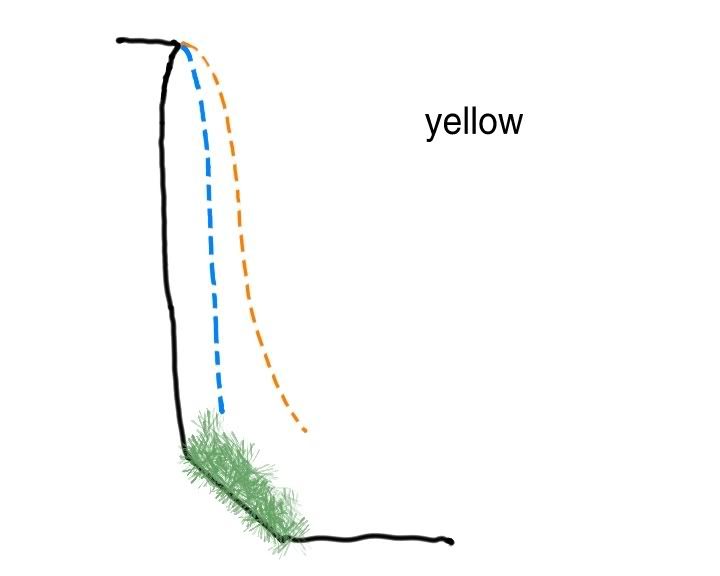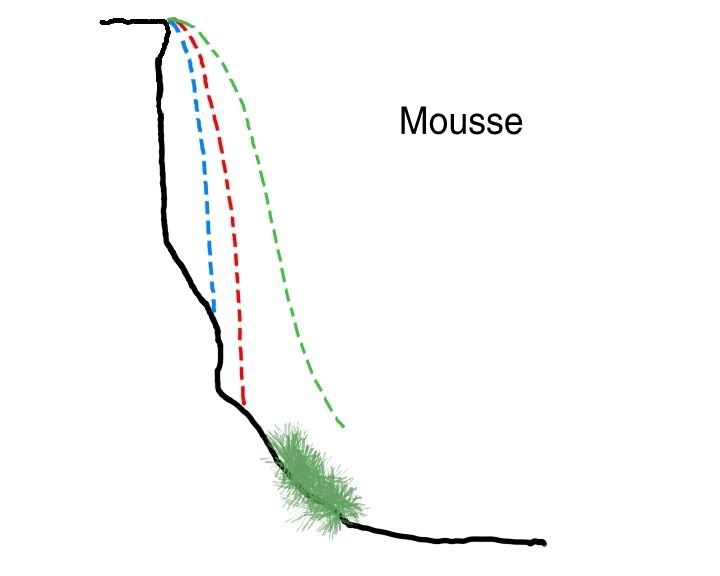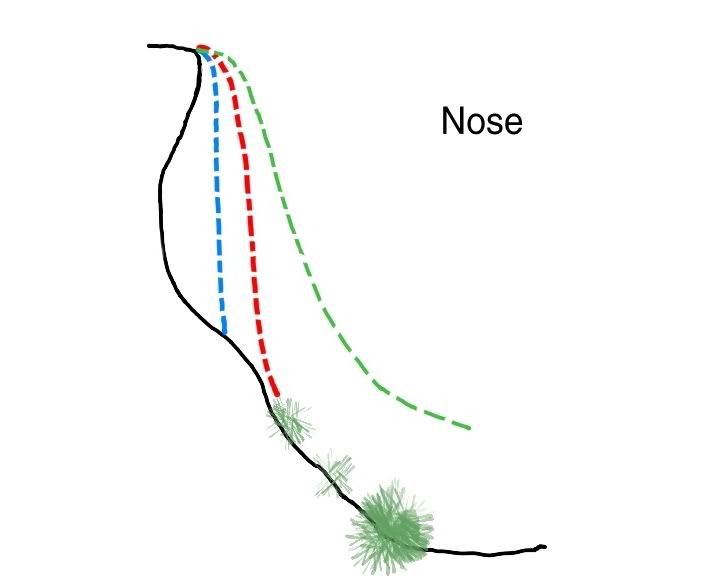Re: [Airgazm] Very good info on BASE in Lauterbrunnen.
sabre210 wrote:
[the following is] a reply to a friend who asked specifically why people were condemning the advice he was given (and subsequently followed) to jump the nose in a boxman and take 5 second delays slider up. I in no way intended or desired to set myself up as an expert on the valley - something which i am patently not. It was simply my advice from one jumper to another and i had no idea it had been reposted over here as a definitive guidline for jumping in the valley.
edited to add above disclaimer -WW this post from basejumper.org
post by Ian as below
-------------------------------
Broadly speaking Yellow Ocean is slightly overhung at the exit, turning vertical quickly, remaining (roughly speaking vertical) until it hits the Talus slope with all the trees on it.

If a jumper does a poor exit, an aerial, falls in boxman, goes unstable, or tracks poorly, you might expect them to have a descent path like the one in blue. They will continue to fall without really getting any closer to the wall until they impact at the top of the tree talus. Because the initial overhang isn't HUGE, it means that a jumper is falling relatively close to the wall and maintaining this all the way down. If on the other hand their track is effective, then they are constantly putting distance between themselves and the wall (the orange path on this diagram).
Now it's fair to assume that most newbies will fall more in common with the blue path than the orange and it's also fair to say they are the group most likely to encounter tracking problems, instability and poor exits. If after launch they are not comfortable with how things are going they will be tempted to deploy early. Slider up, this is a big problem. The deployment will be mushy and slow and easily influenced by shifts in the harness, wind, assymetric body position, assymetric pressurisation of the cells. An off heading (accompanied with twists) is highly likely. The big danger now is that the jumper is faced with a wall relatively close to them and a subsequent cliffstrike several hundred feet above ground with no outcrops or ledges to arrest the fall. Unless they get the canopy turned quickly, they have hundreds of feet of rock to bounce down. Many jumpers have died at Yellow exactly like this (including #95,#96), and many more have got hurt this way.
The safest way to jump Yellow is to exit and track away from the cliff and take an appropriate delay, deploying with sufficient height to correct an off heading and make the landing area. Under delaying is dangerous but just not as obvious as over delaying.
Le Mousse is slightly overhung at the exit, turning vertical quickly and then several hundred feet below this it starts to become positive (underhung) and continues to flare out until it meets the tree covered slope.

Now in this instance, a boxman, unstable jump or prolonged aerial will mean that they will impact the cliff around the 7th second of freefall (again indicated by the blue line) - well short of the delay you might expect to get from such a high cliff. This has killed many jumpers, including experienced jumpers doing aerials or back t[/image]o earth (including #56, #105) and newbies who haven't tracked. Assuming the jumper gets some form of track going they might avoid the initial impact point but are now having to maintain an effective track to outfly the remainder of the underhanging positive cliff (the red path). An offheading at this point puts them close to the various ledges, and even if they can avoid iminent impact they still have the ledges to outfly. An effective track (green path) will mean good seperation from the rock throughout.
The Nose (depending on the exit point) is very overhung, turning underhung after several hundred feet and continues aggressively positive (being very underhung) until it meets the small tree covered talus.

The Nose, being overhung means that relatively safe short delays are possible, but the jumper would have to be configured appropriately (slider down with a 42 pilot chute) to ensure a crisp deployment in the overhung section of the wall. An unintentional or intentional shortened delay slider up again means less than ideal opening characteristics and more chance of an off heading, except the altitude eaten up by the slower deployment starts to take the jumper dangerously out of the overhung section and into the positive. Once again jumpers have been killed here by poor tracking skills or unstable exits followed by early deployments leading to off headings and strikes (#65,#116). Sadly at the Nose, unlike Yellow a strike on the positive part of the cliff means you'll either come to rest on ledge (if you're lucky) or you'll continue to impact and risk entanglement within your own canopy. Once again, effective tracking will lead to object separation which mean more distance from the wall which equals more time to deal with any off headings.
Now add to the equation the fact that inexperienced jumpers are less likely to make good solid exits, are less likely to track effectively, are less likely to be wearing tracking pants which might assist in their performance, are less likely to deal with an off-heading as quickly and you might begin to see why putting an inexperienced big wall jumper off any wall in Lb is 'potentially' a recipe for disaster, and even more so off Le Mousse and The Nose.
With regards the hand held part of the debate. Well, going handheld is in itself not a big issue providing you intend to take an appropriate delay (3 to 4 secs maximum which would mean slider down). After that, any jumper is seriously risking bridle entanglements with the body/limbs, entanglement of the bridle with the pilot chute, being turned in freefall due to the increased drag on the side of the body holding the pilot chute and potential premature deployments due to the drag on the bridle dislodging the pins.
Hope this helps Dave, but please be assured that jumping boxman from any wall in the valley is far from ideal. It is of course preferable to falling unstable and deploying unstable but it is still FAR from ideal. For these reasons, many, many jumpers will say that LB is not the place to be going to learn longer delays.
ian
------------------------------------
from basejumping.org
edited to add more from the original author -WW
sabre210 wrote:
The Nose, being overhung means that relatively safe short delays are possible off exit point 1, but the jumper would have to be configured appropriately (slider down with a 42 pilot chute) to ensure a crisp deployment in the overhung section of the wall. Short delays from all other exit points are not recommended due to outcrops. As many people are unaware of which exit point is which, it might be prudent to assume that a short delay from the Nose is less than ideal, even properly configured. An unintentional or intentional shortened delay slider up again means less than ideal opening characteristics and more chance of an off heading, except the altitude eaten up by the slower deployment starts to take the jumper dangerously out of the overhung section and into the positive. Once again jumpers have been killed here by poor tracking skills or unstable exits followed by early deployments leading to off headings and strikes (#65,#116). Sadly at the Nose, unlike Yellow a strike on the positive part of the cliff means you'll either come to rest on ledge (if you're lucky) or you'll continue to impact and risk entanglement within your own canopy. Once again, effective tracking will lead to object separation which mean more distance from the wall which equals more time to deal with any off headings.



